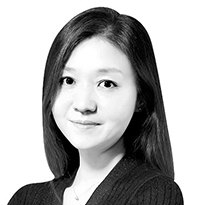Devise follow-up actions on unification
Published: 20 Aug. 2024, 20:04

Yoo Jee-hye
The author is the head of the diplomatic and security news department at the JoongAng Ilbo.
I come from a separated family. My paternal grandfather went missing after he was captured by the North Korean People’s Army, which swept through the South after the outbreak of the Korean War in 1950. A manager of a textile factory at the time, he went to work even during the war and never returned home.
I also come from a family of national merit. My maternal grandfather worked as a teacher and joined the South Korean military as an interpreter officer after the Korean War broke out. A native of North Korea, he had lied about his hometown to join the South Korean military because he was afraid that he would be rejected for his background.
Although my family’s stories may be astonishing, the real tragedy of the Korean Peninsula is that it is not hard to find stories like mine. That’s why I empathized with President Yoon Suk Yeol when he said, “As long as the state of division persists, our liberation will remain incomplete” during the Liberation Day address last week.
I was also glad that the president identified the people of North Korea as the main actors of unification — not the North Korean regime — when he announced the Aug. 15 Unification Doctrine in the speech. The regime and the people need to be approached separately because treating the two together can trigger confusion.
The Unification Doctrine — which includes three visions, three strategies and seven measures to promote unification — is reasonable. The logical structure of the doctrine is also quite solid. Nevertheless, something feels frustratingly empty. As it feels like being dragged along by ideological justification, you can’t help but wonder if there really is a unified Korea at the end of the road.
“Only when a unified free and democratic nation rightfully owned by the people is established across the entire Korean Peninsula will we finally have complete liberation,” Yoon declared in the address. It cannot be more true, but it also means that the current Kim Jong-un regime of the North has no place in the unified land Yoon envisions. Pyongyang will most likely interpret it as an attempt to shake its entire system.
The North Korean regime is an anti-state entity and North Korean people are citizens of the South, according to our Constitution and the rulings of the Supreme Court. Article 4 of the Constitution also states, ”The Republic of Korea shall seek unification and shall formulate and carry out a policy of peaceful unification based on the basic free and democratic order.” We must reject the North Korean regime while embracing the North Korean people as the subject of unification. After Kim amended the North’s Constitution to deny the concepts of the same nationality and unification, Yoon made a logical countermeasure by stressing that the two Koreas are one people and one nation.
Unfortunately, we cannot deal with North Korea through the law and logic. No one denies that the Kim regime must end to achieve unification. But unless we pursue unification by force, the starting point should be dialogue and negotiation. In short, we need to “dance with the devil.”
Yoon’s proposal to establish a working-level dialogue council between the two Koreas must have come from this concern. The proposal to establish a conversation channel to discuss an agenda is significant, but no effort has been made to create conditions for the North to accept it.
President Yoon made a convincing decision to set the direction of the unification doctrine to focus on “what we can do first” since the North completely shut down talks. At the same time, we need to think about expanding common points among ourselves. When we are as inclusive as possible, the unification doctrine can be powerful. The National Community Unification Formula, which was created 30 years ago, remains the official unification plan of the Korean government because it received bipartisan support.
In that sense, it is unfortunate that the reunification doctrine was announced at the Liberation Day ceremony, which was held amid extreme political conflict. Furthermore, it was also awkward — even if it was deemed necessary — that Yoon devoted a significant portion of the address to attacking “false propaganda based on so-called fake news and pseudo-logic” in the South.
I am not saying that the unification doctrine is wrong. I am especially excited about the various action plans centered on improving the human rights situation in the North. It will be possible to move beyond the mistakes of previous administrations that either turned a blind eye to the issue or used it as a tool to pressure the North. But preparations for unification cannot be done unilaterally. I look forward to seeing some follow-up actions demonstrating this administration’s sincerity.










with the Korea JoongAng Daily
To write comments, please log in to one of the accounts.
Standards Board Policy (0/250자)